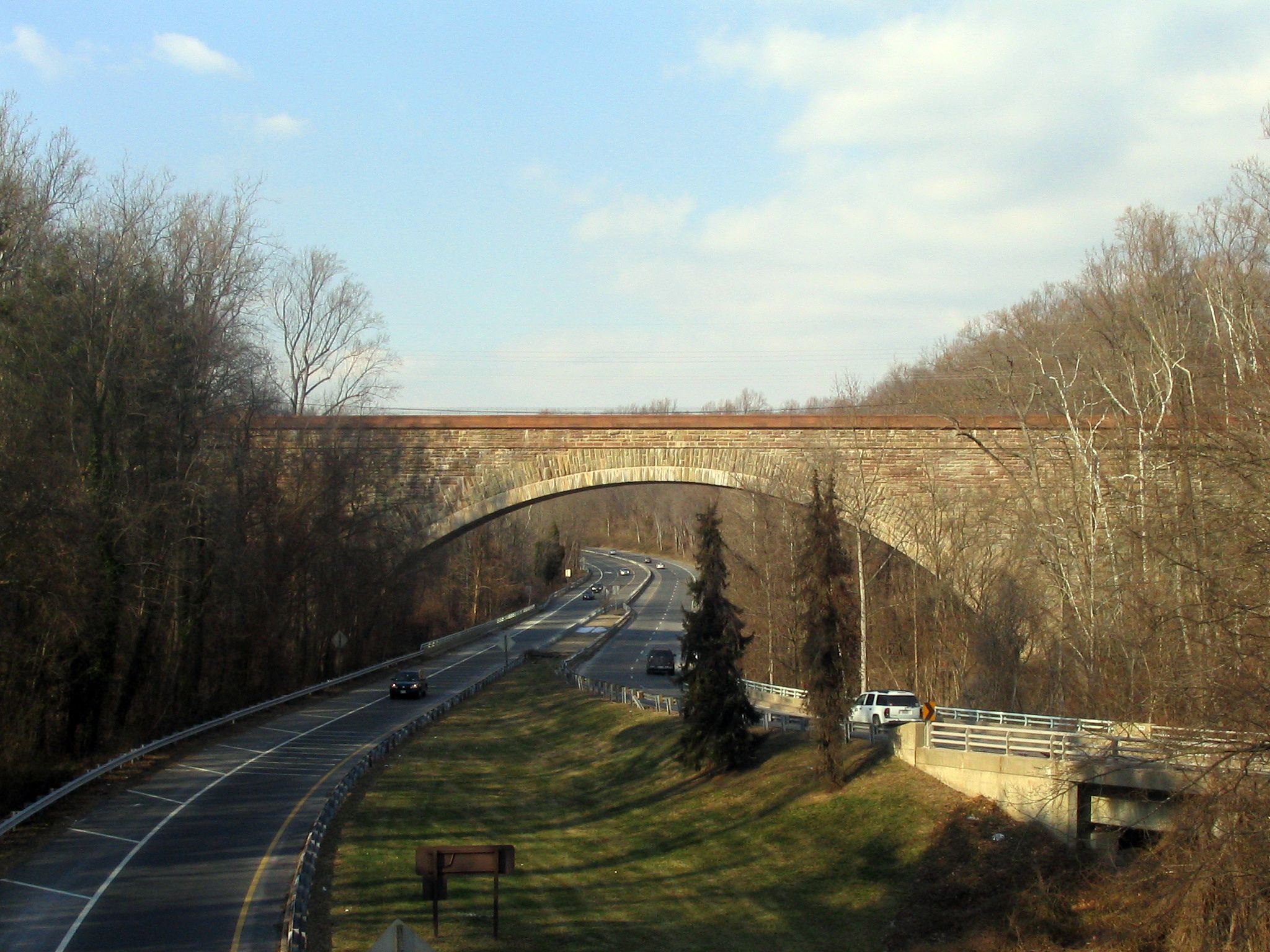- Washington Aqueduct
Infobox nrhp
name = Washington Aqueduct
nrhp_type = nhl

caption = TheUnion Arch Bridge carries the Washington Aqueduct acrossCabin John Creek .
location = 5900 MacArthur Blvd., NWWashington, D.C.
nearest_city =
lat_degrees =
lat_minutes =
lat_seconds =
lat_direction =
long_degrees =
long_minutes =
long_seconds =
long_direction =
area =
built = 1853-1864
architect =Montgomery C. Meigs
architecture =
designated=November 7 ,1973
added =September 8 ,1973
visitation_num =
visitation_year =
refnum = 73002123
mpsub =
governing_body =US Army Corps of Engineers The Washington Aqueduct is anaqueduct that provides the publicwater supply system servingWashington, D.C. and parts of its suburbs. One of the first major aqueduct projects in theUnited States , the Aqueduct was commissioned by Congress in 1852, and construction began in 1853 under the supervision ofMontgomery C. Meigs and theUS Army Corps of Engineers (which still owns and operates the system). Portions of the Aqueduct went online onJanuary 3 ,1859 , and the full pipeline began operating in 1864. [Harry C. Ways, "The Washington Aqueduct: 1852-1992." (Baltimore, MD: U.S. Army Corps of Engineers, Baltimore District, 1996)] The system has been in continuous use ever since. It is listed as aNational Historic Landmark , and theUnion Arch Bridge within the system is listed as aHistoric Civil Engineering Landmark .Design and facilities
The centerpiece of the Aqueduct is a 12-
mile (19 km) pipeline which connects the system'sdam at Great Falls with theDalecarlia Reservoir on the border withMontgomery County, Maryland . The pipeline runs along what is nowMacArthur Boulevard , traversing some of the higher cliffs along thePotomac River .The Union Arch Bridge carries the pipeline and MacArthur Boulevard over Cabin John Creek and the
Cabin John Parkway near the community ofCabin John, Maryland . This bridge was the longestmasonry arch bridge in the world for 40 years after its completion. [cite web
url=http://www.sycamoreisland.org/articles/sa200403.htm
title=A Sycamore Neighbor: The Washington Aqueduct
author=Norman Metzger
month=March | year=2004
publisher=Sycamore Islander] [cite web
url=http://www.nps.gov/choh/historyculture/thewashingtonaqueductsystem.htm
title=The Washington Aqueduct System
author=National Park Service
date=July 19, 2006]Water from Dalecarlia also flows on to the
Georgetown Reservoir in Georgetown. From there, some of the waters flow to theMcMillan Reservoir through the Washington City Tunnel.ystem expansion
The system originally used a single pipe for water delivery, and did not have any
water treatment plants, relying instead on thereservoir s to act assettling basin s. By the turn of the 20th century, however, Washington's growth and the high amount ofsediment in the Potomac's water kept the reservoirs from doing their jobs well, and so the first treatment plant, a massiveslow sand filter bed system, was installed at McMillan Reservoir, and was completed in 1905. [Scott, Pamela (2007), [http://www.usace.army.mil/publications/eng-pamphlets/ep870-1-67/ "Capital Engineers: The U.S. Army Corps of Engineers in the Development of Washington, D.C., 1790-2004."] Chapter 4. (Washington, DC: U.S. Army Corps of Engineers.) Publication No. EP 870-1-67.] The regular use ofchlorine as adisinfectant began in 1923 at the McMillan plant. The McMillan plant was not replaced until 1985, when arapid sand filter plant was opened adjacent to it. [Ways, "op. cit."] Efforts are under way to redevelop the land the slow sand plant used, while maintaining some of the plant's sand silos for historical purposes.In the 1920s, the Aqueduct was upgraded with the addition of a second pipe from Great Falls to Dalecarlia, and a rapid sand filter plant was built at Dalecarlia Reservoir, which went online in 1927. The Dalecarlia plant is the biggest of the two plants in the system, having been upgraded in the 1950s, and is the plant that serves the
Virginia communities that use the Aqueduct. An additional intake was built at Little Falls in the 1950s.Operations and service area
The Aqueduct is a
wholesale water supplier. The communities it serves are responsible for billing customers and managing water mains. The service area is:
* Washington, D.C. and most of the federal installations in the city (via DCWASA)
*Arlington County, Virginia
* The city ofFalls Church, Virginia and part of Fairfax County (particularly McLean).References
External links
* [http://washingtonaqueduct.nab.usace.army.mil/ Washington Aqueduct - Official site] US Army Corps of Engineers
* [http://www.nps.gov/choh/History/Structures/Aqueduct.html A longer history of the system, from the C&O Canal site] National Park Service
* [http://tps.cr.nps.gov/nhl/detail.cfm?ResourceID=1401&resourceType=Structure National Historic Landmarks Program: Washington Aqueduct] National Park Service
* [http://www.hq.usace.army.mil/history/Vignettes/Vignette_59.htm US Army Corps of Engineers – Historical Vignettes]
Wikimedia Foundation. 2010.
